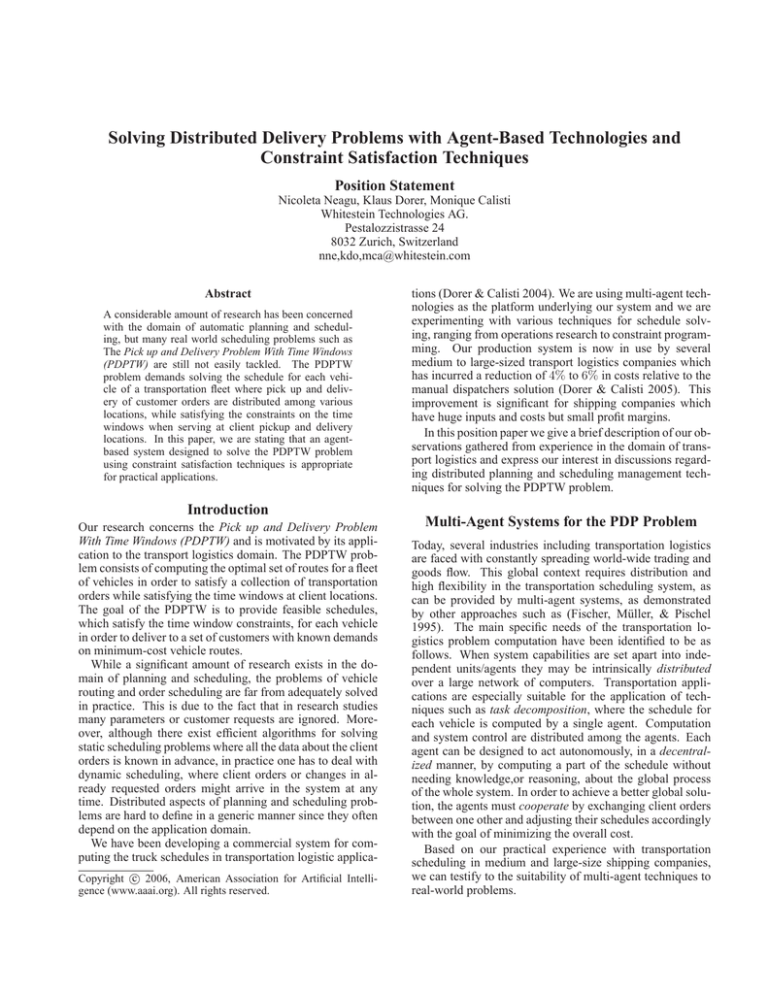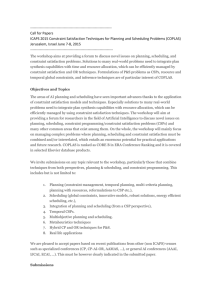
Solving Distributed Delivery Problems with Agent-Based Technologies and
Constraint Satisfaction Techniques
Position Statement
Nicoleta Neagu, Klaus Dorer, Monique Calisti
Whitestein Technologies AG.
Pestalozzistrasse 24
8032 Zurich, Switzerland
nne,kdo,mca@whitestein.com
Abstract
A considerable amount of research has been concerned
with the domain of automatic planning and scheduling, but many real world scheduling problems such as
The Pick up and Delivery Problem With Time Windows
(PDPTW) are still not easily tackled. The PDPTW
problem demands solving the schedule for each vehicle of a transportation fleet where pick up and delivery of customer orders are distributed among various
locations, while satisfying the constraints on the time
windows when serving at client pickup and delivery
locations. In this paper, we are stating that an agentbased system designed to solve the PDPTW problem
using constraint satisfaction techniques is appropriate
for practical applications.
Introduction
Our research concerns the Pick up and Delivery Problem
With Time Windows (PDPTW) and is motivated by its application to the transport logistics domain. The PDPTW problem consists of computing the optimal set of routes for a fleet
of vehicles in order to satisfy a collection of transportation
orders while satisfying the time windows at client locations.
The goal of the PDPTW is to provide feasible schedules,
which satisfy the time window constraints, for each vehicle
in order to deliver to a set of customers with known demands
on minimum-cost vehicle routes.
While a significant amount of research exists in the domain of planning and scheduling, the problems of vehicle
routing and order scheduling are far from adequately solved
in practice. This is due to the fact that in research studies
many parameters or customer requests are ignored. Moreover, although there exist efficient algorithms for solving
static scheduling problems where all the data about the client
orders is known in advance, in practice one has to deal with
dynamic scheduling, where client orders or changes in already requested orders might arrive in the system at any
time. Distributed aspects of planning and scheduling problems are hard to define in a generic manner since they often
depend on the application domain.
We have been developing a commercial system for computing the truck schedules in transportation logistic applicac 2006, American Association for Artificial IntelliCopyright gence (www.aaai.org). All rights reserved.
tions (Dorer & Calisti 2004). We are using multi-agent technologies as the platform underlying our system and we are
experimenting with various techniques for schedule solving, ranging from operations research to constraint programming. Our production system is now in use by several
medium to large-sized transport logistics companies which
has incurred a reduction of 4% to 6% in costs relative to the
manual dispatchers solution (Dorer & Calisti 2005). This
improvement is significant for shipping companies which
have huge inputs and costs but small profit margins.
In this position paper we give a brief description of our observations gathered from experience in the domain of transport logistics and express our interest in discussions regarding distributed planning and scheduling management techniques for solving the PDPTW problem.
Multi-Agent Systems for the PDP Problem
Today, several industries including transportation logistics
are faced with constantly spreading world-wide trading and
goods flow. This global context requires distribution and
high flexibility in the transportation scheduling system, as
can be provided by multi-agent systems, as demonstrated
by other approaches such as (Fischer, Müller, & Pischel
1995). The main specific needs of the transportation logistics problem computation have been identified to be as
follows. When system capabilities are set apart into independent units/agents they may be intrinsically distributed
over a large network of computers. Transportation applications are especially suitable for the application of techniques such as task decomposition, where the schedule for
each vehicle is computed by a single agent. Computation
and system control are distributed among the agents. Each
agent can be designed to act autonomously, in a decentralized manner, by computing a part of the schedule without
needing knowledge,or reasoning, about the global process
of the whole system. In order to achieve a better global solution, the agents must cooperate by exchanging client orders
between one other and adjusting their schedules accordingly
with the goal of minimizing the overall cost.
Based on our practical experience with transportation
scheduling in medium and large-size shipping companies,
we can testify to the suitability of multi-agent techniques to
real-world problems.
Constraint Satisfaction for Scheduling
Research work in the constraint satisfaction problems
(CSPs) domain has brought about new ways of tackling
combinatorial optimization problems, including scheduling.
When dealing with scheduling problems with complex side
constraints, CSPs techniques offer high flexibility and robustness through constraint propagation, an advantage over
operations research methods such as mathematical programming, which lack the flexibility needed for solving problems
with side constraints.
In practical applications many more parameters and side
constraints, which characterize the client requests, occur
than in theoretical studies. An example of such side constraints are the time constraints on the driver schedule in
order to satisfy legislation, e.g. the driver must take a
45 minute break after 4 h 30 of continuous driving. This
kind of constraint is hard to handle in integer programming
based systems, whereas constraint programming can handle
them in a natural way. This example illustrates the flexibility of the constraint programming framework. Moreover,
variables, domain values and constraints can be adjusted to
the specific problem conditions, without necessarily affecting problem solving procedures and algorithms. This allows easy customization of the system to new client requirements. Flexibility can be also increased by solution adaptation techniques based on constraint satisfaction problems
properties (Neagu & Faltings 2005). Moreover, constraint
programming based on weighted constraints, which can be
violated at a certain cost, can be used in order to model costs
(for the roads) and preferences (for the customers as well as
for suppliers). Every way of violating a constraint carries
with it the cost of that violation, and the cost of a solution
is a combination of the costs of each constraint violation it
implies. This enables a flexible approach to calculate costs
for plan deviations in real-world scenarios.
The CSPs have been also studied in dynamic environments where the set of constraints changes during problem
solving, e.g., constraints can be added or removed, variables
and values can change. Because constraints change it may
be necessary to abandon the current solution for a new one.
We are seeking for adaptation techniques which allow for
partial reuse of previously computed solutions which can be
helpful during subsequent problem solving in order to minimize the need for re-computation.
Another advantage of CSPs is that they can be represented
and solved also in distributed environments. A distributed
CSP has the variables and constraints distributed among distinct autonomous agents. Each agent has one or multiple
variables and tries to determine its/their value(s). In general, there exist intra- and inter-agent constraints which the
value assignment must satisfy. In order to verify inter-agent
constraints, i.e., constraints between variables controlled by
distinct agents, some form of agent communication needs to
be supported.
In our transportation logistics system we are using constraint satisfaction techniques for solving the schedules of
each vehicle. From our experience, the number of orders
to be scheduled in a vehicle tends to be quite small, up to
20 client orders, and for these cases it is possible to per-
form a complete search. In situations where the number of
client orders increases, local search constraint satisfaction
algorithms can be used.
Discussion
The PDPTW problem is hard to solve. For medium and large
scale applications the global optimal solutions are hard to
reach and thus good approximation and heuristic approaches
are more feasible. In the real world large, constantly growing and distributed companies show a strong interest in automating and optimizing their dispatching process. Thus,
finding solutions for distributed solving of the PDPTW
problem is of major importance for large-scale practical applications. There are few open issues which are important
for practical applications of the PDPTW problem.
Global solution: While localizing the computation of
a route’s schedules in individual agents, it is difficult to
achieve high-quality global solutions. How can the computation of a global solution be improved without a centralized
schedule?
Suitability to distribution: In very large transportation
applications, the need for a distributed representation is
mandatory. How should the multi-agent system be distributed for large applications? Which agents should be concerned with certain client orders? And which agents should
collaborate?
Dynamic aspects: The problem is called dynamic, as
opposed to static, if the transportation requests are not all
known in advance. This means that new requests can be
received and treated during the optimization process itself.
Which techniques are most appropriate to handle these problems?
Conclusion
We believe that multi-agent systems as a support platform
for the PDPTW problem, and constraint satisfaction techniques as the solver for scheduling aspects are suitable techniques for transportation logistics applications. We have a
transportation logistics production system which can handle
transportation scenarios consisting of thousands of client orders. We would like the aforementioned aspects, global solution, dynamic aspect and suitability to distribution, in the
context of distributed plan and schedule management.
References
Dorer, K., and Calisti, M. 2004. Agent-based Dynamic
Transport Optimization. In Whitestein Technologies Technical Report, WT-2004-05.
Dorer, K., and Calisti, M. 2005. An Adaptive Solution
to Dynamic Transport Optimization. In Proceedings of the
AAMAS05 industry track.
Fischer, K.; Müller, J. P.; and Pischel, M. 1995. Cooperative Transportation Scheduling: an application Domain for
DAI. In Journal of Applied Artificial Intelligence.
Neagu, N., and Faltings, B. 2005. Approximating Partial Interchangeability in CSP Solutions. In Proc. of
FLAIRS05.



